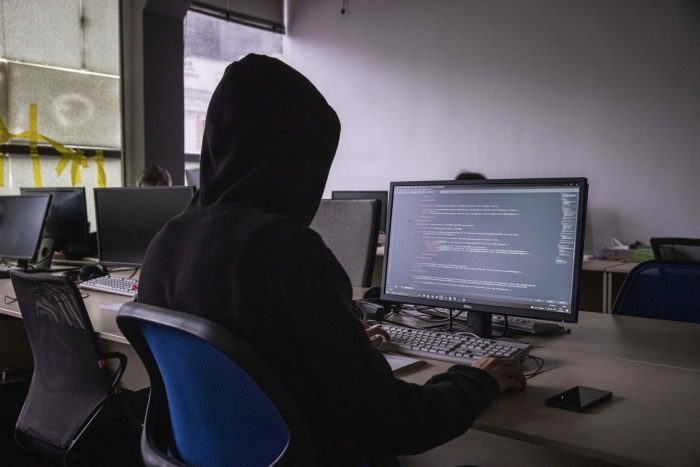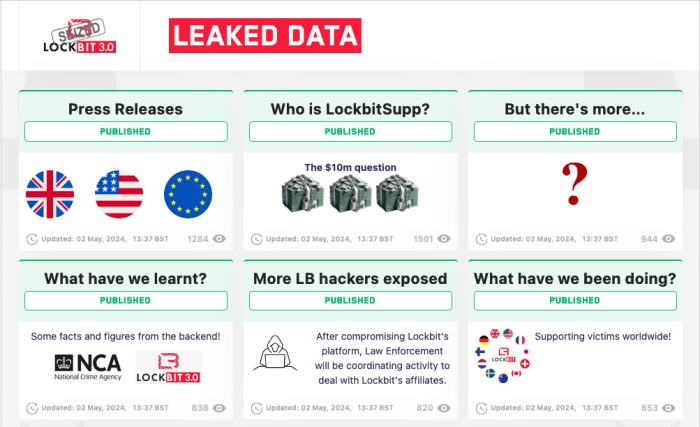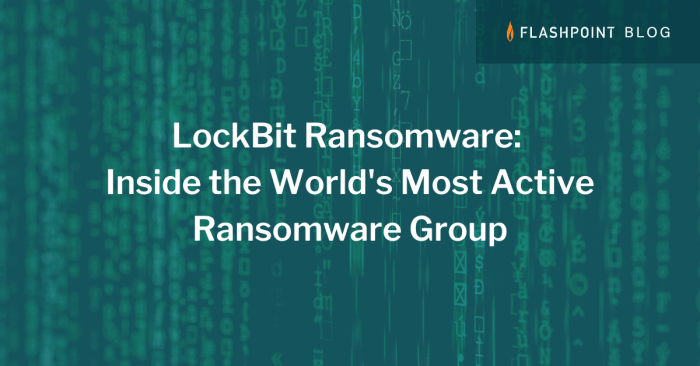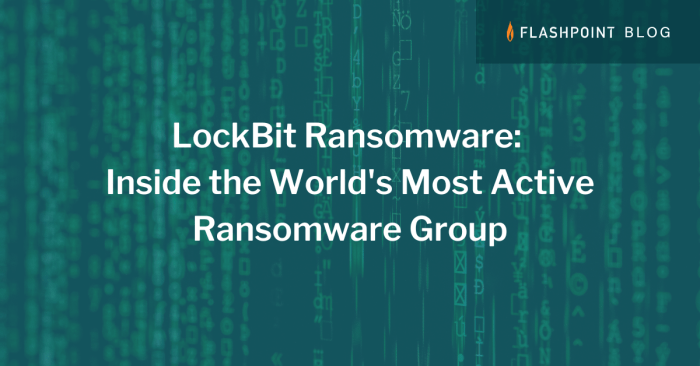Meet the leader of lockbit the most active ransomware gang ever – Meet the leader of LockBit: the most active ransomware gang ever. This isn’t just a story about cybercrime; it’s a glimpse into the shadowy world of international cyberwarfare, where data is the new currency and fear is the primary weapon.
LockBit has become a global menace, targeting businesses, governments, and individuals alike, holding their data hostage and demanding exorbitant ransoms. The impact of their attacks is far-reaching, disrupting economies, hindering critical services, and eroding trust in digital systems.
Who are the individuals behind this digital empire, and what drives them to inflict such chaos?
This blog post delves into the enigmatic world of LockBit, exploring the origins of the group, their intricate tactics, and the devastating consequences of their actions. We’ll examine the challenges of unmasking the leader, analyzing their motives, and understanding their strategies.
Finally, we’ll discuss the ongoing battle against LockBit, exploring the countermeasures being implemented by law enforcement and cybersecurity experts to combat this evolving threat.
The Rise of LockBit: A Global Threat

LockBit, a notorious ransomware group, has emerged as a significant force in the global cybercrime landscape, leaving a trail of havoc in its wake. Its rapid rise to prominence can be attributed to a combination of factors, including its sophisticated tactics, aggressive operational strategies, and the evolution of its ransomware-as-a-service (RaaS) model.
LockBit’s Emergence and Evolution
LockBit first appeared in 2019, initially operating as a traditional ransomware group, encrypting victims’ data and demanding payment for its decryption. However, the group quickly transitioned to a RaaS model, allowing affiliates to leverage its ransomware toolkit and infrastructure to launch attacks.
This strategic shift enabled LockBit to expand its reach and significantly increase the number of victims it targeted.
Factors Contributing to LockBit’s Success
Several factors have contributed to LockBit’s remarkable success, solidifying its position as one of the most active and prolific ransomware groups in the world:
Ransomware-as-a-Service (RaaS) Model
LockBit’s adoption of the RaaS model has been instrumental in its rapid growth. This model allows individuals with limited technical expertise to participate in ransomware attacks by renting access to LockBit’s tools and infrastructure. The RaaS model has significantly lowered the barrier to entry for cybercriminals, enabling a wider range of actors to engage in ransomware activities.
Sophisticated Tactics and Strategies
LockBit employs a range of sophisticated tactics and strategies to maximize its impact. These include:
- Double Extortion:LockBit leverages the threat of data exfiltration, stealing sensitive data from victims and threatening to release it publicly if ransom demands are not met. This strategy increases pressure on victims to pay, as the potential for reputational damage and financial loss from data leaks is significant.
Get the entire information you require about zero emissions cargo shipping the old fashioned way on this page.
- Advanced Encryption Techniques:LockBit uses robust encryption algorithms and techniques to ensure the effective encryption of victims’ data, making decryption without the decryption key virtually impossible.
- Anti-Forensics Measures:LockBit implements measures to hinder forensic investigations, making it difficult for security researchers and law enforcement to track the group’s activities and identify its members.
Aggressive Operational Strategies
LockBit’s operational strategies are characterized by their aggressiveness and efficiency. The group focuses on targeting high-value victims, often prioritizing organizations in critical sectors such as healthcare, finance, and manufacturing. LockBit’s operators are highly skilled and adaptable, constantly evolving their tactics and techniques to stay ahead of security defenses.
LockBit’s Tactics Compared to Other Ransomware Groups
LockBit’s tactics and strategies share similarities with other prominent ransomware groups, such as REvil and Conti. All three groups employ the RaaS model, engage in double extortion, and utilize sophisticated encryption techniques. However, LockBit distinguishes itself by its aggressive targeting of high-value victims, its relentless pursuit of new attack vectors, and its willingness to engage in high-profile attacks.
“LockBit is a highly organized and well-funded ransomware group that has demonstrated a willingness to target high-profile victims and engage in large-scale attacks.”
[Source
Cybersecurity Firm Report]
Unmasking the Leader: Meet The Leader Of Lockbit The Most Active Ransomware Gang Ever
The identity of the individual or group behind LockBit remains a mystery, shrouded in layers of anonymity and obfuscation. While speculation abounds, concrete evidence is scarce, making it challenging to definitively pinpoint the mastermind behind this global ransomware threat.
Challenges in Identifying LockBit’s Leadership
The difficulty in identifying LockBit’s leadership stems from the group’s meticulous efforts to conceal their true identities. They employ various techniques, including:
- Use of Proxies and VPNs:LockBit operators utilize proxy servers and virtual private networks (VPNs) to mask their real IP addresses and locations, making it challenging to trace their online activities.
- Cryptocurrency Transactions:LockBit demands ransom payments in cryptocurrencies, such as Bitcoin, which are notoriously difficult to trace and link to specific individuals. This further complicates efforts to identify the group’s financial trail.
- Decentralized Infrastructure:LockBit’s infrastructure is likely decentralized, with multiple servers and operators spread across various countries, making it harder to pinpoint a central command center.
- Constant Evolution:LockBit’s developers continuously update their ransomware code and infrastructure, making it difficult for security researchers to keep up with their latest tactics and identify their true identities.
Speculated Locations and Origins, Meet the leader of lockbit the most active ransomware gang ever
While concrete evidence remains elusive, several factors suggest that LockBit’s operations are likely rooted in Russia and Eastern Europe:
- Language and Culture:The LockBit ransomware notes, which are the messages left for victims, are often written in Russian, suggesting a connection to Russian-speaking individuals or groups.
- Cybercrime Hubs:Russia and Eastern Europe have long been known as hubs for cybercrime activities, with a thriving underground market for ransomware and other malicious software.
- Government Support:Some experts speculate that LockBit may have ties to Russian intelligence agencies, who may provide support and protection to cybercriminals operating within their borders.
Known and Suspected Identities
Despite the challenges, some individuals have been linked to LockBit, though their involvement remains unconfirmed:
- “The Dark Overlord”:This individual, known for their involvement in various ransomware attacks, has been linked to LockBit by some security researchers, but their connection remains speculative.
- “REvil”:A notorious ransomware group that was previously active, is believed to have connections to LockBit, with some experts suggesting they may be related or have shared members. However, this link is also based on speculation and circumstantial evidence.
LockBit’s Modus Operandi
LockBit’s modus operandi is a carefully crafted strategy designed to maximize the chances of success and minimize the risk of detection. Their operations involve meticulous targeting, sophisticated technical methods, and a relentless approach to extortion. This section delves into the intricacies of their operations, examining their target selection, technical methods, and the unique characteristics of their ransomware.
Target Selection
LockBit’s target selection is driven by a combination of factors, including industry vulnerability, potential financial gain, and the likelihood of successful extortion. Their targets typically include:
- Critical Infrastructure:LockBit has targeted critical infrastructure sectors such as energy, transportation, and healthcare. These sectors often rely on outdated systems and have a high tolerance for downtime, making them attractive targets. For example, in 2022, a LockBit attack on a major US energy company resulted in a significant disruption to operations, highlighting their willingness to target critical infrastructure.
- Manufacturing and Supply Chain:Manufacturing and supply chain companies are often targeted due to their reliance on complex IT systems and their vulnerability to disruptions. A LockBit attack on a global manufacturing company in 2023 resulted in the shutdown of multiple production facilities, causing significant financial losses.
- Financial Institutions:LockBit has also targeted financial institutions, including banks, insurance companies, and investment firms. These institutions often hold sensitive financial data and have a strong incentive to pay ransoms to avoid reputational damage and regulatory fines.
- Government Agencies:LockBit has targeted government agencies at both the national and local levels. These agencies often hold valuable data, such as sensitive information on citizens or government operations. A LockBit attack on a US state government agency in 2021 resulted in the theft of personal data of millions of residents.
Technical Methods and Tools
LockBit employs a sophisticated arsenal of technical methods and tools to infiltrate systems, encrypt data, and extort victims. These methods include:
- Exploiting Vulnerabilities:LockBit leverages known vulnerabilities in software and operating systems to gain initial access to victim networks. They often use publicly available exploits or develop their own custom tools to bypass security measures.
- Phishing and Social Engineering:LockBit uses phishing emails, malicious attachments, and social engineering tactics to trick unsuspecting users into granting them access to their systems. They may impersonate legitimate organizations or individuals to gain trust and exploit vulnerabilities.
- Remote Access Tools:Once they gain initial access, LockBit uses remote access tools (RATs) to control infected systems remotely. These tools allow them to move laterally within the network, escalate privileges, and access sensitive data.
- Data Encryption:LockBit encrypts victim data using strong encryption algorithms, rendering it inaccessible without the decryption key. Their ransomware typically uses a combination of symmetric and asymmetric encryption techniques to ensure data confidentiality and prevent unauthorized access.
- Data Exfiltration:Before encrypting data, LockBit often steals sensitive information, such as financial records, intellectual property, and customer data. They then threaten to release this data publicly if the ransom is not paid, further increasing the pressure on victims.
Ransomware Features
LockBit’s ransomware exhibits unique features that distinguish it from other ransomware groups:
- Advanced Encryption Algorithms:LockBit employs advanced encryption algorithms, such as AES-256, to ensure data confidentiality and prevent decryption without the appropriate key. This makes it difficult for victims to recover their data without paying the ransom.
- High Ransom Demands:LockBit typically demands significant ransoms, often in the millions of dollars, for the decryption key. They may adjust the ransom amount based on the victim’s financial resources and the potential impact of the attack.
- Negotiation Strategies:LockBit is known for its willingness to negotiate with victims. They may offer discounts or payment plans to incentivize payment. However, they are also known for their ruthless tactics and have been known to leak stolen data or increase ransom demands if victims refuse to negotiate.
- Data Leak Sites:LockBit operates data leak sites where they publicly display stolen data from victims who refuse to pay the ransom. This tactic further increases pressure on victims and serves as a deterrent for potential future targets.
The Impact of LockBit

LockBit, the most active ransomware gang, has wreaked havoc on businesses, governments, and individuals globally. Their attacks have resulted in widespread disruptions, crippling infrastructure, and causing significant financial losses. The consequences of LockBit’s activities extend far beyond individual victims, impacting entire industries and economies.
Economic and Societal Impact
LockBit’s attacks have a profound impact on both the economy and society. The financial losses incurred by victims can be substantial, ranging from millions to billions of dollars. Businesses may face costly downtime, data recovery expenses, and reputational damage. Governments may experience disruptions in essential services, leading to public inconvenience and security risks.
Individuals may lose personal data, financial records, and access to critical services.
Countering LockBit
The emergence of LockBit, a prolific and adaptable ransomware group, has presented a formidable challenge to law enforcement agencies and cybersecurity professionals worldwide. The group’s sophisticated tactics, rapid evolution, and relentless pursuit of lucrative targets have demanded a multifaceted approach to combat its operations effectively.
Law Enforcement Initiatives
Law enforcement agencies worldwide have implemented a range of strategies to disrupt LockBit’s activities and bring its members to justice. These efforts encompass international collaboration, intelligence sharing, and proactive investigations.
- International Cooperation:Law enforcement agencies from various countries have formed alliances to share intelligence, coordinate investigations, and execute joint operations against LockBit. This collaboration is crucial in dismantling the group’s global network and tracking its activities across borders. For instance, the FBI, Europol, and other international law enforcement agencies have worked together to disrupt LockBit’s infrastructure and apprehend its members.
- Intelligence Gathering:Law enforcement agencies actively gather intelligence on LockBit’s operations, including its infrastructure, communication channels, and financial networks. This intelligence is used to identify targets, disrupt attacks, and apprehend suspects. Law enforcement agencies often leverage techniques like network analysis, malware analysis, and financial investigations to uncover crucial information about LockBit’s activities.
- Proactive Investigations:Law enforcement agencies conduct proactive investigations to identify and apprehend LockBit members. These investigations involve tracing financial transactions, identifying compromised systems, and gathering evidence to build criminal cases against individuals involved in the group’s activities. These investigations often require close collaboration with cybersecurity firms and private sector partners.
Cybersecurity Professionals and Companies
Cybersecurity professionals and companies play a vital role in mitigating the threat posed by LockBit ransomware. Their expertise in threat intelligence, vulnerability assessment, and incident response is crucial in protecting organizations and individuals from attacks.
- Threat Intelligence:Cybersecurity professionals and companies collect and analyze data on LockBit’s tactics, techniques, and procedures (TTPs) to understand the group’s evolving methods. This intelligence helps organizations identify potential threats, implement appropriate security measures, and develop effective incident response plans.
- Vulnerability Assessment:Cybersecurity professionals conduct vulnerability assessments to identify and remediate weaknesses in an organization’s security posture. This helps to prevent LockBit from exploiting vulnerabilities to gain access to systems and data. Regular vulnerability assessments are essential for maintaining a robust security posture.
- Incident Response:Cybersecurity professionals and companies provide incident response services to organizations that have fallen victim to LockBit attacks. These services involve containing the attack, mitigating its impact, and recovering compromised data. Incident response teams possess the expertise and resources to handle ransomware incidents effectively.
Best Practices for Organizations
Organizations can take proactive steps to protect themselves from LockBit ransomware attacks. These best practices involve implementing robust security protocols, maintaining regular data backups, and developing comprehensive incident response plans.
- Security Protocols:Organizations should implement strong security protocols to prevent LockBit from gaining access to their systems. These protocols include:
- Multi-factor Authentication (MFA):MFA adds an extra layer of security by requiring users to provide multiple forms of authentication, making it more difficult for attackers to gain unauthorized access.
- Strong Passwords and Password Management:Organizations should encourage the use of strong passwords and implement password management tools to prevent password reuse and improve password security.
- Regular Security Updates:Patching software vulnerabilities promptly is crucial to prevent attackers from exploiting known weaknesses. Organizations should implement a robust patch management process to ensure timely updates.
- Network Segmentation:Segmenting the network into smaller, isolated segments can limit the impact of a successful attack. This makes it harder for attackers to spread laterally across the network.
- Security Awareness Training:Educating employees about ransomware threats and best practices for protecting against them is crucial. Regular security awareness training can help reduce the risk of phishing attacks and other social engineering tactics.
- Data Backups:Maintaining regular backups of critical data is essential for recovery in the event of a ransomware attack. Organizations should implement a robust backup strategy that includes:
- Offline Backups:Store backups offline, separate from the network, to prevent them from being encrypted by ransomware.
- Regular Backups:Back up data regularly to ensure that recent versions are available in case of an attack.
- Testing Backups:Regularly test backups to ensure they are functional and can be restored successfully.
- Incident Response Plans:Organizations should develop and maintain comprehensive incident response plans to guide their actions in the event of a ransomware attack. These plans should include:
- Containment:Isolate the affected systems to prevent the spread of ransomware.
- Recovery:Restore data from backups and remediate the affected systems.
- Communication:Establish clear communication channels for internal and external stakeholders.
- Legal and Regulatory Compliance:Ensure compliance with relevant legal and regulatory requirements.
The Future of LockBit

The trajectory of LockBit, the most active ransomware gang, is difficult to predict with certainty. However, by analyzing its past behavior, current trends in the cybersecurity landscape, and the strategies employed by other ransomware groups, we can anticipate the potential future of LockBit and its impact on the global cybersecurity landscape.
LockBit’s Continued Evolution
LockBit’s continued evolution is likely to pose significant challenges for cybersecurity professionals. The ransomware group has consistently demonstrated a willingness to adapt and innovate, introducing new features and functionalities to its malware. For example, LockBit 3.0 introduced the ability to encrypt data on network-attached storage (NAS) devices, expanding the scope of its attacks.
The Rise of New Ransomware Variants
The emergence of new ransomware variants is a constant threat. These variants often incorporate advanced evasion techniques, exploit vulnerabilities in software, and utilize sophisticated encryption algorithms. As new variants emerge, it becomes increasingly difficult for security solutions to keep pace, leading to a heightened risk of successful attacks.
Strategies and Tactics
LockBit and other ransomware groups are likely to continue employing a range of strategies and tactics to maximize their impact. These may include:
- Targeting Critical Infrastructure:As critical infrastructure becomes increasingly interconnected and reliant on digital systems, it presents an attractive target for ransomware groups. Attacks on critical infrastructure can have devastating consequences, disrupting essential services and causing significant economic damage.
- Exploiting Software Vulnerabilities:Ransomware groups are likely to continue exploiting software vulnerabilities to gain access to systems. This will require organizations to prioritize patching and updating their software regularly to mitigate this risk.
- Using Social Engineering:Social engineering tactics, such as phishing emails and malicious websites, can be used to trick individuals into granting access to systems. Organizations need to educate their employees about social engineering techniques and implement robust security measures to prevent these attacks.
- Leveraging Dark Web Markets:Ransomware groups are increasingly using dark web markets to sell stolen data, ransomware tools, and access to compromised systems. This creates a thriving ecosystem for cybercrime, making it more difficult to disrupt these operations.
- Using Double Extortion Tactics:Double extortion involves both encrypting data and threatening to leak stolen data if the ransom is not paid. This tactic increases the pressure on victims to pay, as the potential reputational damage and financial losses from data leaks can be significant.





